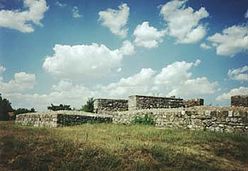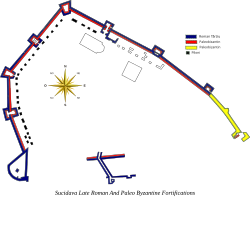Sucidava
| Castra Sucidava | |
|---|---|
 Ruins of Sucidava, modern Romania | |
| Known also as | Castra of Celeiu |
| Abandoned | 6th century |
| Attested by | Tabula Peutingeriana |
| Previous fortification | Dacian |
| Place in the Roman world | |
| Province | Dacia |
| Administrative unit | Dacia Malvensis |
| Nearby water | Danubius |
| Structure | |
| — Stone structure — | |
| Location | |
| Altitude | c. 37 m |
| Place name | Cartier Celei |
| Town | Corabia |
| County | Olt |
| Country | |
| Reference | |
| RO-LMI | OT-I-s-A-08492 |
| Site notes | |
| Recognition | |
| Condition | Ruined |
| Excavation dates | 1900 [1] |
| Archaeologists | Pamfil Polonic [1] |
Sucidava (Sykibid after Procopius,[2] Σucidava after Pârvan, where Σ is pronounced "sh"[3]) is a Dacian and Daco-Roman historical site, situated in Corabia, Romania, on the north bank of the Danube. The first Christian Basilica established in Romania can be found there and the foot of a Roman bridge over the Danube built by Constantine the Great to link Sucidava with Oescus (today in Bulgaria, in Moesia). There is also a secret underground fountain which flows under the walls of the town to a water spring situated outside.
From an archaeological point of view, the coins found at Sucidava show an uninterrupted series from Aurelian (270-275) to Theodosius II (408-450).[citation needed] The archaeological evidence show that in AD 443 or 447 the city was sacked by the Huns, and was restored under Justin I 518-527 or Justinian I 527-565.[citation needed] Around 600, it seems that the Roman garrison abandoned the city.[2][dead link]
See also
References
- ^ a b "Manuscrisele lui Pamfil Polonic". cimec.ro. Retrieved 15 December 2012.
- ^ a b Olga Karagiorgou http://egg.mnir.ro/pdf/Karagiorgou_Container.PDF
- ^ Pârvan - ştiri din Dacia Malvensis http://www.cimec.ro/Arheologie/ParvanArticole/ParvanStiriNouaDinDaciaMalvensis.pdf)
Additional References
- Paul Lachlan MacKendrick, "The Dacian Stones Speak", Chapel Hill: University of North Carolina Press, 1975. ISBN 0-8078-1226-9
- Notitia Dignitatum cca 395-413
External links
- Sucidava on Tabula Peutingeriana: http://www.euratlas.net/cartogra/peutinger/7_thracia/thracia_4_1.html
- Template:Ro icon "Archaeological Excavation Report"
- Photo gallery
- Gabriel Vasile, "Analiza antropologică a unui schelet descoperit la Sucidava - Celei (judeţul Olt)", Cercetări Arheologice, 13/2006, at National Museum of Romanian History
- http://www.threemonkeysonline.com/als/_sucidava_romania_eu_expansion.html
- Roman castra from Romania - Google Maps / Earth




